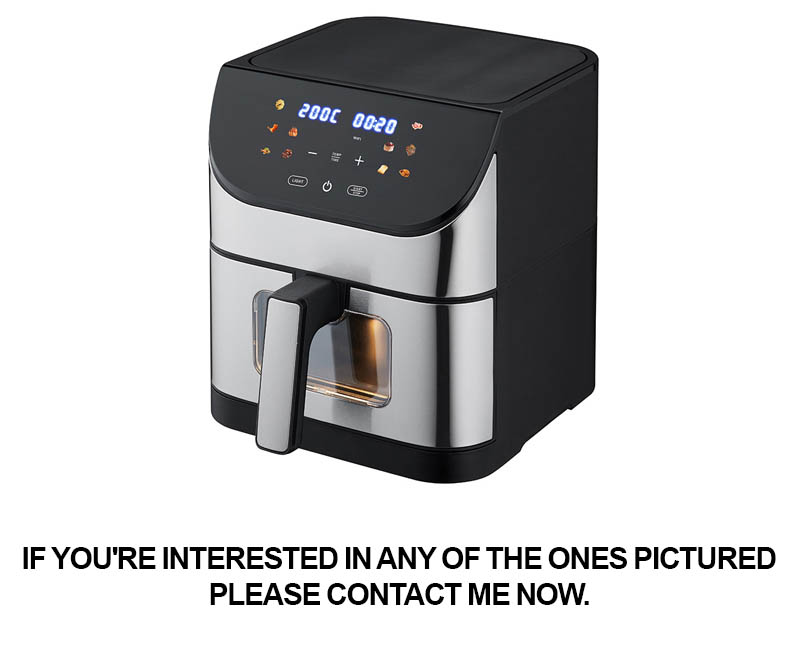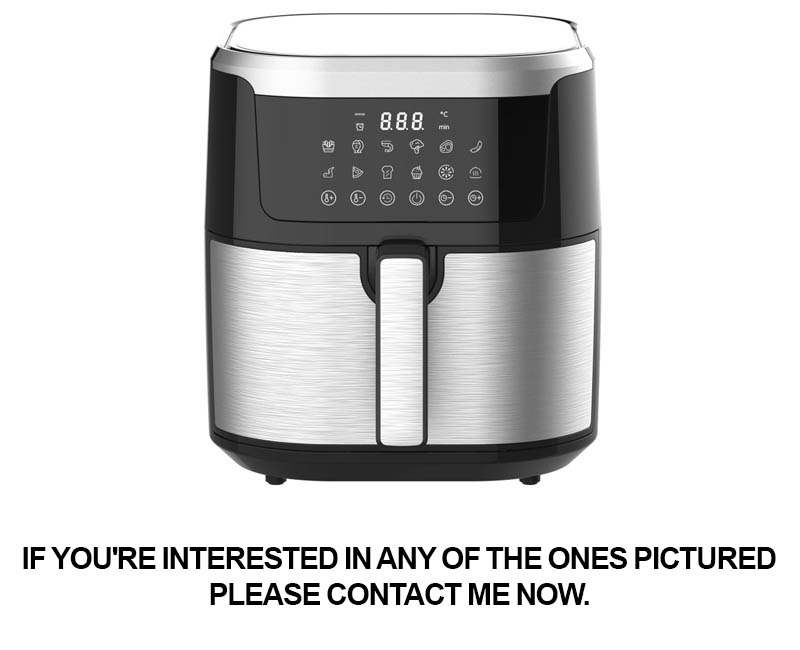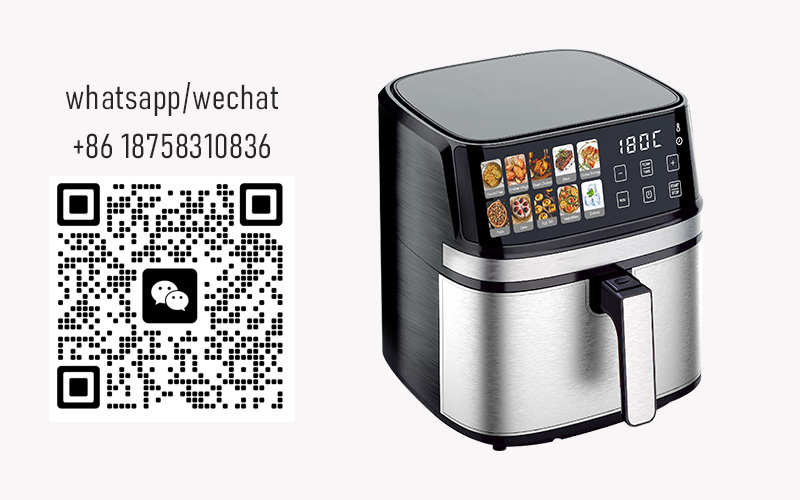In a world where convenience meets culinary desires, the fast food industry has long been a staple in our daily lives. But with health concerns on the rise, the industry is facing a pivotal transformation. Enter the air fryer, a kitchen marvel that’s not just a gadget but a revolutionary tool reshaping how fast food is prepared and enjoyed. From healthier options to increased efficiency, the air fryer is leading the charge in the fast food revolution. Let’s dive into how this innovation is changing the landscape of quick-service dining.
The Rise of Fast Food and the Need for Efficiency
In the bustling streets of modern cities, the fast food industry has become an integral part of daily life. With our increasingly busy lifestyles, the convenience of quick meals has become a necessity for many. This surge in demand has led to a relentless pursuit of efficiency in the fast food sector.
The convenience of fast food has been a double-edged sword. While it offers a quick solution to hunger, it has also been criticized for its contribution to unhealthy eating habits. As the industry continues to grow, there’s a pressing need to streamline operations without compromising on quality or speed.
Fast food chains have been under constant pressure to innovate and stay relevant. The competition is fierce, with new concepts and technologies emerging almost daily. This has forced established brands to reevaluate their processes and find ways to enhance efficiency.
Efficiency in the fast food industry isn’t just about reducing wait times. It’s also about optimizing the use of resources, minimizing waste, and ensuring that every aspect of the operation runs smoothly. This includes everything from inventory management to kitchen preparation.
The rise of fast food has also brought about a shift in consumer expectations. Customers now demand not only speed but also quality and health. They want their meals to be prepared quickly, yet they’re also increasingly conscious of the nutritional content of their food.
To meet these demands, fast food chains have had to invest in technology and training. Automation has become a key component in the quest for efficiency, with machines taking over tasks that were once performed by humans. However, this shift hasn’t come without its challenges.
One of the biggest hurdles has been the integration of new technology into existing systems. Fast food kitchens are complex environments, with a myriad of variables that need to be balanced. The introduction of new equipment and processes requires careful planning and execution to ensure that they complement the existing workflow.
Moreover, the human element remains crucial. Despite the advancements in automation, the need for skilled labor hasn’t diminished. In fact, with the introduction of new technologies, the skills required have evolved. Employees must now be adept at operating complex machinery while maintaining a high level of customer service.
Another significant factor in the push for efficiency is the rise of digital ordering and delivery services. With the advent of mobile apps and online platforms, customers can now order their food from the comfort of their homes. This has led to a surge in off-premise sales, further increasing the pressure on fast food chains to optimize their operations.
The need for efficiency is also driven by the desire to reduce costs. As the cost of labor continues to rise, fast food chains are looking for ways to minimize their overhead. This often involves finding more efficient ways to prepare food, reducing waste, and streamlining supply chains.
In recent years, there has been a noticeable trend towards healthier fast food options. Consumers are no longer satisfied with the traditional fried and processed fare. They’re seeking meals that are lower in fat, calories, and sodium, yet still satisfying and delicious.
This shift has prompted fast food chains to explore alternative cooking methods, such as air frying. Air fryers have gained popularity for their ability to produce crispy, golden-brown results with minimal oil. This not only appeals to health-conscious consumers but also helps reduce the cost of ingredients and the environmental impact of food preparation.
The rise of fast food and the need for efficiency are inextricably linked. As the industry continues to evolve, fast food chains must find innovative ways to meet the demands of their customers while maintaining profitability. The pursuit of efficiency is not just about cutting corners; it’s about creating a sustainable and competitive business model that can thrive in an ever-changing landscape.

Introducing the Air Fryer: A Game-Changer for Fast Food Chains
In the bustling world of fast food, the demand for speed, taste, and health continues to grow. Enter the air fryer, a humble kitchen appliance that’s quietly revolutionizing how fast food chains operate. This compact, countertop marvel has swiftly risen to prominence, offering a solution that promises to redefine the very essence of quick-service dining.
Once reserved for home chefs looking to enjoy crispy, fried food with less oil, the air fryer now commands attention in commercial kitchens. Its design is simple yet ingenious: by using a fan to circulate hot air around food, it achieves the same golden-brown finish and irresistible crunch as traditional deep-frying, but with a fraction of the oil.
The transition from deep fryer to air fryer isn’t just a matter of swapping out equipment; it’s a strategic move by fast food chains to meet the evolving demands of consumers. These eateries are now able to offer a broader range of options that cater to health-conscious diners without sacrificing the taste they’ve come to love.
What sets the air fryer apart from other cooking methods is its versatility. It can handle everything from chicken wings to onion rings, French fries to mozzarella sticks, with ease. This means that fast food joints can maintain their menu variety while also providing a healthier option for customers who are increasingly seeking balance in their diets.
One of the standout benefits of the air fryer is its efficiency. The device operates at a lower temperature than traditional deep-frying, reducing the cooking time significantly. This not only speeds up service for customers but also means less energy consumption for the establishment. The air fryer is also much quieter, a crucial factor for restaurants trying to create an enjoyable dining experience.
Another key advantage is the reduction in kitchen space required. The compact size of air fryers allows them to be installed almost anywhere, from a bustling kitchen counter to a small kiosk. This is particularly beneficial for fast food chains with limited space or those looking to expand their operations.
In terms of maintenance, the air fryer is a winner. With no deep fryer’s oil to change or dispose of, the cleaning process is much more manageable. This not only saves time but also minimizes the risk of oil fires, a common concern in commercial kitchens.
From a financial perspective, the cost savings are substantial. By using less oil and requiring less energy, fast food chains can cut their operational costs without compromising on the quality of their food. This is a win-win situation for both the businesses and their customers.
Moreover, the air fryer’s health benefits are hard to ignore. By reducing the amount of oil used in cooking, these devices can significantly cut down on the calorie content of fried foods, making them more accessible to those looking to maintain a healthy lifestyle. The healthier option doesn’t mean sacrificing flavor either; the air fryer locks in the natural juices of the food, ensuring that it comes out crispy and delicious.
The adoption of air fryers by fast food chains also speaks to a broader shift in consumer preferences. Health is no longer just a buzzword; it’s a priority. Fast food businesses that embrace this technology are not only keeping up with the times but are also setting themselves apart from competitors who haven’t made the switch.
Fast food giants have begun to introduce air fryer items into their menus, and the results have been encouraging. Customers are loving the taste and texture of the air-fried dishes, and the feedback has been overwhelmingly positive. The air fryer is not just a tool for cooking; it’s a new way to connect with customers and a chance to redefine the fast food experience.
The future of fast food is here, and it’s being powered by air fryers. As more restaurants invest in this innovative technology, we can expect to see a wave of health-conscious, delicious, and efficient fast food options on the market. The air fryer isn’t just changing the game—it’s changing the world of fast food as we know it.

How Air Fryers Work: A Quick Guide
Air fryers have revolutionized the way we cook, and their impact on fast food chains is undeniable. Here’s a quick guide to understand how these compact appliances work their magic.
The Science Behind the Air FryerAir fryers operate on a simple yet highly effective principle. They use hot air to circulate around the food, mimicking the deep-frying process without the need for gallons of oil. The air is blown through the appliance at high speeds, which helps to cook the food evenly and create that coveted crispy texture.
Hot Air DistributionThe key to an air fryer’s success lies in its ability to distribute heat evenly. Inside the appliance, there’s a fan that pushes hot air from the heating element across the food. This continuous flow of hot air ensures that the surface of the food is cooked to a perfect golden brown, while the inside remains tender and juicy.
The Oil FactorOne of the most appealing aspects of air fryers is their low oil requirement. While traditional frying involves submerging food in oil, air fryers typically use just a tablespoon or two to add flavor and prevent sticking. This dramatic reduction in oil not only cuts down on calories but also makes for a healthier cooking method.
The Cooking ProcessWhen you place food in an air fryer, the cooking process begins with the food being coated lightly with oil or a non-stick spray. The high temperature inside the appliance then causes the surface of the food to heat up rapidly. This initial heat creates a Maillard reaction, which is responsible for the browning and flavor development.
Simultaneous CookingAir fryers are designed to cook food from all angles simultaneously. The hot air stream ensures that the surface of the food is constantly being exposed to heat, leading to an even cook throughout. This is a stark contrast to traditional ovens, where heat is often concentrated in one area, leading to uneven cooking.
Temperature ControlAnother advantage of air fryers is their ability to maintain precise temperatures. This allows users to achieve different cooking outcomes depending on the type of food being prepared. For instance, chicken pieces may be cooked at a higher temperature to achieve a crispy exterior, while vegetables might be cooked at a lower temperature to retain their texture and color.
The Non-Stick FactorAir fryers are often equipped with non-stick cooking surfaces, which not only make cleanup easier but also ensure that the food doesn’t stick to the bottom or sides of the appliance. This feature is particularly beneficial when cooking delicate items like fish fillets or breaded chicken.
Cooking Times and Energy EfficiencyAir fryers are generally faster than traditional ovens, reducing cooking times by up to 75%. This efficiency not only saves time but also energy, as air fryers use less power than conventional ovens. The quick cooking times are especially beneficial for fast food chains looking to streamline their operations.
Safety FeaturesModern air fryers come with a range of safety features designed to prevent accidents. These include automatic shut-off mechanisms that activate when the appliance is left unattended or when the cooking time has elapsed. Some models also have cool-touch exteriors to prevent burns.
VersatilityWhile air fryers are often associated with fried foods, they are surprisingly versatile. They can be used to roast, grill, bake, and even dehydrate. This versatility makes them a valuable addition to any kitchen, from home chefs to fast food establishments.
In conclusion, the air fryer’s ability to cook food with minimal oil, distribute heat evenly, and offer precise temperature control has made it a game-changer for fast food chains. Its efficiency, health benefits, and versatility make it a perfect fit for a world that’s increasingly conscious of both taste and nutrition.

The Benefits of Using an Air Fryer in Fast Food Preparations
The air fryer, once a niche kitchen gadget, has burst onto the scene in a big way, offering fast food chains a revolutionary way to cook. Here’s why this nifty appliance is a game-changer for preparing fast food:
Its key feature lies in the circulating hot air. Instead of using gallons of oil, an air fryer cooks food by enveloping it with hot air that circulates rapidly around the chamber. This method, often called “frying in air,” allows food to achieve a crispy outer layer while remaining much healthier than traditional deep-frying.
By reducing the need for oil, air fryers can significantly cut down on the calories and fats in fast food items. This is a huge benefit for health-conscious customers and a major selling point for fast food chains looking to appeal to a wider demographic.
The cooking process in an air fryer is surprisingly fast. It doesn’t take long to preheat the unit, and once the hot air is flowing, food cooks quickly. This efficiency is perfect for busy fast food kitchens that need to serve a high volume of orders in a short amount of time.
The air fryer’s ability to cook a variety of foods without the mess of oil is a major plus. Foods like chicken wings, fries, and even vegetables come out with a delightful crunch, all while minimizing splatters and cleaning up time.
Not only does the air fryer cook with less oil, but it also produces less smoke compared to deep frying. This cleaner cooking environment is better for the kitchen staff and customers, reducing the risk of odors and improving air quality.
One of the most attractive aspects of the air fryer for fast food preparation is its ability to customize cooking temperatures. Different foods require different heat levels to achieve the perfect texture and crispiness. The air fryer allows for precise control, ensuring consistency across the menu.
Another advantage is the versatility of the air fryer. It can handle a wide range of cooking techniques, from roasting to baking, which means it can be used to prepare more complex dishes that might not be feasible in a traditional fast food kitchen setup.
Safety is also a key factor. The air fryer’s enclosed cooking chamber reduces the risk of burns and accidental spills that can occur with hot oil. This is especially important in high-traffic kitchens where accidents can lead to costly downtime and injured employees.
Maintaining the air fryer is straightforward, which is crucial in a fast-paced kitchen environment. A simple wipe-down with a damp cloth or a quick cleaning cycle is all it takes to keep the unit in top condition.
For fast food chains looking to reduce costs, the air fryer is a smart investment. It can be more energy-efficient than deep fryers, especially when you consider the cost of oil and the energy it takes to heat large quantities of oil.
In terms of flavor, the air fryer doesn’t compromise. Foods retain their natural taste and aromas, often enhancing them with the added benefit of a crispy outer layer. This means that customers won’t miss the deep-fried taste or texture, making the switch to air-fried options a seamless one.
Lastly, the air fryer’s compact size means it can fit into tight kitchen spaces, which is ideal for fast food outlets with limited kitchen area. This space-saving feature is a bonus for operators looking to optimize their workspace without sacrificing the quality of their food.
The benefits of using an air fryer in fast food preparations are clear: healthier options, quicker cooking times, reduced cleanup, and the potential for cost savings. It’s no wonder that more and more fast food chains are embracing this modern kitchen marvel.

Fast Food Revolution: Menu Items Transformed
In the world of fast food, innovation is a cornerstone of survival. One such innovation that has sparked a revolution is the integration of air fryers into menu items. These compact, countertop appliances have not only changed the way we cook at home but have also transformed the landscape of fast food establishments.
Gone are the days of greasy, fried snacks. Air fryers have introduced a healthier twist to beloved fast food items. By circulating hot air around food, they create a crispy outer layer while reducing the oil content significantly. Let’s delve into some of the menu items that have been reimagined with the help of air fryers.
Take the classic french fries, for instance. A staple in fast food joints, they’ve long been synonymous with high-calorie and high-fat meals. With the introduction of air fryers, these fries are now a healthier option, retaining their beloved crispy texture but with less oil. The hot air zips around the potatoes, cooking them through and forming a delicate crust, all without the deep fryer’s high fat count.
Similarly, fried chicken, another fast food favorite, has been reinvented. Traditional fried chicken requires a lot of oil to achieve its golden, crispy skin. Air frying changes the game, using a fraction of the oil while delivering the same crunch. The process involves lightly coating the chicken pieces with a blend of herbs and spices, then cooking them in the air fryer until they’re juicy on the inside and perfectly crispy on the outside.
The transformation isn’t limited to meat items. Vegetables have also found their way into the air fryer’s realm. Stuffed bell peppers, crispy kale chips, and even air-fried zucchini fries have become popular due to their low-oil content and high flavor. These items are not just healthy but also offer a delightful crunch, making them a great addition to any fast food menu.
Burgers, a cornerstone of fast food, have also been given a facelift. Traditional burger buns are often laden with calories. However, with air frying, you can enjoy a healthier burger with a whole-grain bun that’s been air-fried to a golden perfection. The patties themselves can be cooked in the air fryer, resulting in a leaner, yet satisfying, meal.
For dessert lovers, the air fryer has introduced healthier options like apple pie with a flaky crust that’s made with less butter. Traditional desserts like cheesecake have also been reimagined, with air frying providing a light, delicate texture that’s far from the indulgence of traditional baking methods.
The versatility of the air fryer has even allowed fast food chains to offer seafood options that were previously unavailable due to the high oil content required for deep frying. Fish and chips, for example, can now be made with minimal oil, preserving the flavor and texture of the fish while keeping the oil content low.
This fast food revolution has also had a profound impact on the way these items are perceived. The idea that fast food can be healthy has become a reality. Consumers who once equated fast food with unhealthy choices are now able to make healthier choices without sacrificing taste or convenience.
The technology behind the air fryer is both simple and ingenious. By utilizing a fan to generate hot air, it cooks food quickly and efficiently. The hot air circulates around the food, ensuring that it cooks evenly and develops a crispy texture without the need for excessive oil. This not only makes the food healthier but also saves time and money for fast food establishments.
Moreover, the use of air fryers in fast food preparations has encouraged the development of new recipes. Chefs and culinary experts are constantly experimenting with the appliance, pushing the boundaries of what is possible with air-fried food. This creativity has led to a plethora of new menu items that cater to a wide range of dietary preferences and restrictions.
In conclusion, the integration of air fryers into fast food preparations has been a game-changer. It has allowed fast food chains to offer healthier options that still satisfy the cravings for crispy, delicious food. From french fries to desserts, the air fryer has transformed menu items, making fast food more accessible to health-conscious consumers without compromising on flavor or texture. It’s a win-win situation that has truly revolutionized the fast food industry.

The Healthier Alternative: Low-Fat, Crispy Treats
In the bustling world of fast food, there’s a silent revolution taking place, and it’s all about healthier alternatives that still satisfy the craving for crispy, delicious treats. The air fryer has emerged as a hero in this culinary transformation, offering a healthier way to savor our favorite fried foods without the guilt. Here’s how it’s changing the game:
Air fryers use a process known as hot air circulation to cook food, which creates a crispy outer layer while reducing the oil content significantly. This innovative cooking method has been embraced by fast food chains looking to offer patrons a more nutritious option without compromising on taste.
One of the most notable changes is the transformation of classic fried snacks. For instance, French fries, once soaked in oil and fried to a golden crisp, can now be prepared in an air fryer. The result is a lighter, less greasy version that still delivers that satisfying crunch. Fast food joints are rebranding their fries as “Air-Popped” or “Oven-Crisp” to highlight the healthier twist.
Chicken wings, a staple in many fast food menus, have also undergone a metamorphosis. By using an air fryer, chefs can achieve that perfect balance of crispy skin and juicy meat without the need for excessive oil. The reduced fat content makes these wings more appealing to health-conscious diners, while still satisfying the deep-fried cravings.
Burgers are another menu item that’s been reimagined. Fast food chains are experimenting with air-fried patties, which are less greasy and more flavorful. The patties retain their juiciness and can be paired with a variety of toppings, from fresh veggies to lower-fat cheese options. The air fryer’s ability to cook burgers to perfection without the traditional greasy finish is a game-changer for those looking to indulge with a cleaner conscience.
Not to be forgotten are the sweets. Donuts, cookies, and pastries are notorious for their high fat and calorie content. However, with an air fryer, these treats can be baked to a golden perfection, significantly reducing the fat content. The result is a lighter, airier texture that’s still rich and indulgent, making it easier for customers to enjoy their favorite pastries without the guilt.
Fast food chains are also looking to the air fryer to introduce new, healthier menu items. For example, a popular salad chain has started offering air-fried chickpeas as a crunchy topping, providing a delightful crunch that’s both satisfying and healthful. Similarly, air-fried vegetables like zucchini fries and sweet potato wedges are becoming a staple, offering a nutritious and flavorful side that can accompany any meal.
The health benefits of air-fried foods are not just limited to the reduction in fat content. The air fryer’s hot air circulation also ensures that food is cooked more evenly, leading to less sticking and a lower risk of burning. This method of cooking also locks in more nutrients, making the food more nutritious than its deep-fried counterparts.
Moreover, the air fryer is a time-saver for fast food chefs. Preparing food in an air fryer is much quicker than traditional frying methods, allowing for more efficient kitchen operations. This efficiency can lead to shorter wait times for customers, a critical factor in the fast food industry.
The environmental benefits of the air fryer are also hard to ignore. With less oil used and a shorter cooking time, there’s less waste and a smaller carbon footprint. Fast food chains are increasingly aware of the importance of sustainability, and the air fryer fits perfectly into their eco-friendly initiatives.
The transformation of menu items through the use of air fryers is not just about offering healthier options; it’s about redefining what fast food can be. Customers are becoming more health-conscious and are seeking out food that doesn’t sacrifice taste for nutrition. The air fryer has provided fast food chains with a powerful tool to meet this demand, making it a staple in the kitchen of the modern fast food establishment.
In conclusion, the healthier alternative presented by the air fryer in fast food preparations is reshaping the industry. It’s not just about reducing fat; it’s about providing a better, more nutritious, and still indulgent dining experience. As the popularity of air fryers continues to grow, we can expect to see even more innovative and healthful menu items that cater to the evolving tastes and needs of consumers.

Efficiency Gains: Quick Service with Great Taste
In the fast-paced world of fast food, the quest for efficiency and quality is relentless. Air fryers have emerged as a game-changer, redefining the way meals are prepared. Here’s a look at how these nifty appliances have led to gains in efficiency while maintaining great taste.
The compact size of air fryers makes them perfect for commercial kitchens where space is at a premium. Unlike traditional deep fryers that require a large amount of oil to cook, air fryers use a fraction of that oil, often just a tablespoon or two. This not only saves on oil costs but also reduces the risk of fires and the need for frequent oil changes. The smaller footprint of air fryers means more counter space, which can be crucial in busy kitchens where every square inch counts.
The cooking process in an air fryer is a marvel of modern technology. It involves circulating hot air around the food at high speeds, which creates a crispy outer layer while cooking the inside without the need for excessive oil. This rapid circulation of air means that food cooks faster than traditional methods, cutting down on wait times for customers. The result is a quicker turnaround for orders, which is a major efficiency gain for fast food chains.
Another aspect of efficiency that air fryers bring to the table is consistency. With precise temperature control and even heating, these appliances ensure that every batch of food comes out the same, reducing the margin for error. This consistency is crucial in fast food, where customers expect a consistent experience with each visit. The ease of use also contributes to efficiency; operators can load the basket, set the temperature, and walk away, knowing that the air fryer will do the rest.
The taste of food cooked in an air fryer is often surprisingly good. While it lacks the deep, rich flavor that traditional fried foods have, the air fryer’s ability to crisp up food without excessive oil means that the natural flavors of the ingredients are preserved. This is a significant advantage for fast food chains looking to offer healthier options without sacrificing flavor.
In addition to speed and consistency, air fryers are versatile. They can handle a wide range of foods, from fries and chicken wings to fish and even vegetables. This versatility means that fast food chains can expand their menu options without the need for multiple fryers or cooking equipment, further enhancing efficiency.
The cost savings from using air fryers are substantial. With lower oil consumption and less equipment to maintain, fast food chains can reduce their operational costs. This is especially important in the competitive fast food industry, where margins are thin and every cost reduction counts.
Moreover, the health benefits of air fryers cannot be overstated. As consumers become more health-conscious, they are looking for options that are lower in fat and calories. Air-fried foods offer a healthier alternative to their deep-fried counterparts, appealing to a broader customer base. This shift towards healthier options can lead to increased customer loyalty and positive brand image.
In the realm of customer satisfaction, efficiency is key. With air fryers, fast food chains can serve customers more quickly, reducing wait times and improving the overall dining experience. Happy customers are likely to return, and in the world of fast food, repeat business is king.
The rise of air fryers in fast food preparations is not just a trend; it’s a revolution. These appliances have redefined the way fast food is cooked, offering a faster, more efficient, and healthier solution. The taste remains great, but the approach to preparing meals has evolved, bringing with it a wave of benefits that extend from the kitchen to the customer’s plate.

Customer Feedback: Love at First Bite
In the world of fast food, the quest for satisfying flavors often comes with a side of regrettable health concerns. However, the introduction of air fryers has sparked a revolution, transforming menu items into healthier, yet still delectable options. Here’s how it’s happening:
The air fryer’s unique design is a marvel of modern culinary innovation. Instead of using gallons of hot oil, it relies on a combination of hot air and convection to cook food. The food is placed in a basket or drawer, surrounded by hot air that whips around, circulating heat and cooking the food from all angles. This process results in a crispy exterior without the greasy feel of traditional deep-frying.
As for the health benefits, they’re clear. By reducing the amount of oil used by up to 80%, air fryers allow for the preparation of low-fat dishes. This shift has been a game-changer for fast food chains looking to cater to health-conscious consumers without sacrificing taste. Chicken wings, french fries, and onion rings—once staples of the greasy spoon—are now lighter and more flavorful than ever before.
But it’s not just about the food itself. The transformation extends to the way fast food is perceived. Once synonymous with indulgence, these chains are now seen as offering a healthier alternative. Families, fitness enthusiasts, and anyone looking for a satisfying meal without the guilt can now find it at their local fast food joint.
The air fryer’s efficiency also plays a significant role. Its compact size means it can be placed on a countertop or in a small kitchen, making it perfect for busy establishments that need to maximize space. The rapid cooking time—typically half that of traditional deep-frying—means faster service and increased capacity. This efficiency translates to more orders served in less time, which is a win for both the business and the customer.
Moreover, the air fryer’s versatility is impressive. It can handle a wide range of foods, from appetizers to desserts. Imagine crispy, golden onion strings as a side to your meal, or even a batch of apple chips for a sweet snack. The possibilities are endless, and each dish retains the same texture and taste as its oil-fried counterpart.
From a business standpoint, the transition to air fryers has also been financially rewarding. The lower cost of cooking with less oil means lower operational expenses. Additionally, the longer shelf life of the oil used in air fryers (which is replaced regularly to maintain quality) can lead to further savings. These factors combined have made the investment in air fryers a smart move for fast food chains.
As for the customers, the results speak for themselves. The love at first bite is evident in the positive feedback received from diners. People who once shied away from fast food due to health worries are now returning for a taste of these new, lighter items. The taste and texture are often praised as being just as good, if not better, than the traditional fried versions.
The air fryer has not only changed the way we think about fast food but has also redefined what it means to eat healthily on the go. It’s a testament to the power of innovation in the food industry and the willingness of consumers to embrace change for the better. In the fast-paced world of fast food, the air fryer is a shining example of how we can enjoy delicious food without compromising our health.

Sustainability and Eco-Friendly Practices
Air fryers have gained popularity not just in home kitchens but have also become a game-changer for fast food chains. These compact appliances have revolutionized the way we think about fried foods, making them healthier and more accessible. The technology behind these devices is surprisingly simple yet highly effective, and it’s reshaping the fast food industry.
The heart of an air fryer is its fan. This fan circulates hot air around the food at high speeds, creating a gentle circulation that simulates the cooking process of deep frying. Unlike traditional deep fryers, air fryers do not submerge food in oil, which drastically reduces the fat content. The food is coated with a light layer of oil, which allows for that classic crispy texture we all love.
This rapid air circulation ensures that the food cooks evenly, without the risk of burning. It’s like a gentle breeze of heat that envelops the food, cooking it from all angles. The result is a deliciously crispy outer layer while keeping the inside tender and juicy. This method of cooking is not only healthier but also more energy-efficient, as it requires less heat than conventional frying methods.
The air fryer’s ability to cook a variety of foods without the need for a large amount of oil is a major benefit. From vegetables to meats and even desserts, the possibilities are endless. This versatility has allowed fast food chains to introduce a wide range of new menu items that are both indulgent and health-conscious.
One of the most appealing aspects of air fryers for fast food chains is the speed at which they can prepare meals. The hot air cooks food much faster than traditional frying, which means shorter wait times for customers. In a fast-paced world, where time is a precious commodity, this efficiency can make all the difference. Quick service without compromising on taste has become a hallmark of the modern fast food experience.
Another advantage is the reduced need for kitchen space. Air fryers are compact and can easily fit into even the smallest of kitchen environments. This is particularly beneficial for fast food chains that operate in limited spaces, such as street food vendors or food trucks. The compact nature of air fryers also allows for a more organized kitchen setup, with less clutter and more efficient workflow.
From a financial standpoint, air fryers are a cost-effective solution for fast food chains. They use less oil, which means fewer purchases and waste disposal costs. Additionally, the energy savings from cooking at lower temperatures can lead to significant long-term cost reductions. The initial investment in an air fryer can be recouped quickly through these savings.
Moreover, the health benefits of air frying have been widely recognized. With less fat and oil, fast food items cooked in an air fryer can have fewer calories, making them a healthier choice for consumers who are mindful of their diet. This has opened up new opportunities for fast food chains to cater to a broader audience, including health-conscious customers who may have previously shied away from traditional fast food offerings.
In recent years, fast food chains have been under increasing pressure to offer more sustainable and eco-friendly options. The use of air fryers aligns with these goals. By reducing oil usage, fast food chains are not only cutting down on costs but also minimizing their environmental impact. The reduction in waste and the efficient use of energy make air fryers a greener choice for the planet.
Customers are also becoming more environmentally conscious, and they appreciate fast food chains that make sustainable choices. By offering low-fat, crispy options prepared with air fryers, fast food brands can appeal to these eco-friendly consumers and build a reputation for being socially responsible.
The transformation of menu items through the use of air fryers has been remarkable. Once a symbol of indulgence, fried foods are now more accessible to those looking for a healthier lifestyle. Fast food chains have introduced new items like air-fried chicken wings, onion rings, and even French fries that are just as crispy and satisfying as their deep-fried counterparts but with a fraction of the fat content.
The adoption of air fryers has also sparked creativity in the culinary world. Chefs and food innovators are experimenting with different recipes and flavor combinations, pushing the boundaries of what we expect from fast food. This has led to a variety of innovative dishes that are not only good for the body but also exciting for the palate.
As the fast food industry continues to evolve, air fryers are playing a pivotal role in shaping its future. The technology has proven to be a win-win for businesses and consumers alike. With their health benefits, efficiency gains, and environmental friendliness, air fryers are more than just a trend—they are a sustainable and forward-thinking solution for the future of fast food.

The Future of Fast Food: Air Fryers Leading the Way
In the fast-paced world of fast food, innovation is key to staying relevant. The introduction of air fryers has sparked a revolution in the industry, offering a path to healthier options without sacrificing the beloved crunch and flavor. Imagine a scenario where the iconic French fries at your favorite fast-food joint are not laden with excessive oil, but still crispy and satisfying. This transformation is not just a culinary evolution; it’s a shift towards a more sustainable and eco-friendly future.
The air fryer’s ability to circulate hot air around food, thereby cooking it without the need for gallons of oil, is a game-changer. It’s a technology that has quietly been revolutionizing home kitchens for years, and now, it’s making its mark in the commercial fast-food landscape. The air fryer’s heat is distributed evenly, which means every bite is cooked to perfection.
One of the most notable benefits is the significant reduction in fat content. Traditional frying methods often leave food with a greasy coating, which can be unhealthy and off-putting for health-conscious consumers. Air-fried foods, on the other hand, are often 70-80% lighter in fat than their deep-fried counterparts. This reduction in fat doesn’t just make the food healthier; it also cuts down on calories, making it a more appealing choice for those looking to maintain a healthy lifestyle.
But it’s not just about health; the taste remains undiminished. The air fryer’s ability to achieve that perfect golden-brown texture without the greasiness of deep-frying is a testament to the technology’s sophistication. It’s all about the science—high temperatures and rapid air circulation create a Maillard reaction that locks in the flavors and gives the food that irresistible crunch.
Fast-food chains have been quick to embrace this technology, recognizing the potential for a rebranding as a healthier alternative. Consider the menu item transformation at a major fast-food chain. The traditional fried chicken has been swapped out for an air-fried version that is just as juicy and crispy. The difference? A much lower fat count, making it a guilt-free indulgence for those looking for a lighter meal.
The transition to air frying also means a more sustainable operation. Less oil used in cooking not only reduces the environmental impact of disposing of used oil but also slashes the costs associated with oil replacement. The reduction in waste is another bonus, as less oil is used, less ends up in the landfill. This shift towards sustainability is a nod to the growing demand from consumers who are increasingly aware of their ecological footprint.
For fast-food workers, the switch to air fryers can also mean a safer work environment. Deep fryers are known to be a fire hazard, and the risk of burns from hot oil is a constant concern. Air fryers, while still hot, eliminate the risk of grease splatters and fires, making the kitchen a safer place to work.
Customer feedback has been overwhelmingly positive. The new, healthier menu items have been greeted with excitement and a sense of relief. Health-conscious diners no longer have to feel guilty about indulging in fast food, while those who aren’t watching their waistline appreciate the familiar taste with a lighter twist.
The success of air frying in the fast-food industry has sparked a wave of innovation. Chains are now experimenting with new ingredients and cooking techniques to create entirely new menu items. Think of air-fried vegetables seasoned to perfection, or even air-fried desserts that are rich in flavor but light in fat. The possibilities are vast, and the industry is just scratching the surface.
As for the future, it’s clear that air fryers are not just a fleeting trend but a cornerstone of the fast-food revolution. They are leading the way towards a more sustainable and health-conscious industry. With advancements in technology, we can expect air fryers to become even more efficient and capable of cooking a wider variety of foods.
In the future, we might see air fryers integrated into the cooking process of not just fast-food chains but also restaurants and even home kitchens. The technology is adaptable and can be scaled up or down to meet the needs of any establishment. The future of fast food is bright, and it’s being illuminated by the glow of air fryers, leading the way to a healthier, more sustainable world.